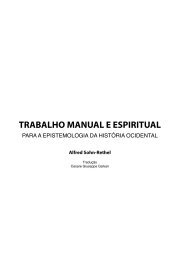Perversion the Social Relation
Perversion the Social Relation
Perversion the Social Relation
- No tags were found...
You also want an ePaper? Increase the reach of your titles
YUMPU automatically turns print PDFs into web optimized ePapers that Google loves.
200 E. L. McCallum<strong>the</strong> news reports of <strong>the</strong> airborne toxic event; reverberations from <strong>the</strong>mid-century war or even <strong>the</strong> typhoid epidemic divert <strong>the</strong> narrative fromits appointed end.This double drive structure plays out in <strong>the</strong> text's trajectory of events.Against <strong>the</strong> advancing cloud, Accident plots <strong>the</strong> narrator's bro<strong>the</strong>r undergoingbrain surgery for a tumor. The skilled precision of <strong>the</strong> surgeonscontrasts with <strong>the</strong> diffuse drive of <strong>the</strong> tumor cells and <strong>the</strong>ir parallelin <strong>the</strong> particles coming from Chernobyl and <strong>the</strong> narrator's meditationson <strong>the</strong> self. Freud tells us that "<strong>the</strong> ego is <strong>the</strong> precipitate of abandonedobject-ca<strong>the</strong>xes and... it contains <strong>the</strong> history of those ca<strong>the</strong>xes." 23 Accident'snarrator shares Freud's science-influenced view of <strong>the</strong> precipitatedego, as she muses on <strong>the</strong> "connectors between <strong>the</strong> neurons called Synapses'below <strong>the</strong> cellular level of <strong>the</strong> brain—<strong>the</strong> connections which bringus life"; 24 toge<strong>the</strong>r <strong>the</strong>se descriptions present a pixelated view of whathad seemed whole, coherent. Notably, this pixelation is depicted on <strong>the</strong>paperback's cover, which has a veil of dots—are <strong>the</strong>y radioactive particlesor newsprint pixels?—over a bucolic scene. Pixels are things weare not supposed to see as individuated; we look through or past <strong>the</strong>mas <strong>the</strong>y constitute <strong>the</strong> image we are supposed to see—like radioactivity,which is also invisible. The conjunction of pixelation and precipitatehere recalls <strong>the</strong> particle; without going so far as to collapse <strong>the</strong>se into<strong>the</strong> same thing, in all three <strong>the</strong>re is this sense of individuated componentsthat in <strong>the</strong>mselves might be insignificant, but <strong>the</strong>ir organizationunites into a completely different, efficacious force. The important thing,<strong>the</strong>n, is <strong>the</strong> mode of organization, and this is precisely why <strong>the</strong> drive,why narrative, and why perversion are important; <strong>the</strong>y all serve as modesof organization. Where <strong>the</strong> emphasis is on fragments, pixelation, it becomesmore difficult to perceive <strong>the</strong> force of <strong>the</strong> drive. That is why structuraldiffusion, this pixelation, makes Accident seem less, shall we say,driven than White Noise.But <strong>the</strong> narrative does have an aim toward which it drives; not onlyis <strong>the</strong> narrator's mind focused on her bro<strong>the</strong>r's surgery as she involvesherself in quotidian activities of gardening, meal preparation, errands,and bicycling, but <strong>the</strong> narrative wraps itself around <strong>the</strong> convention of aday in <strong>the</strong> life. This temporal organization is stronger in Accident thanin White Noise, which, though its finalchapter details a sunset, none<strong>the</strong>lesssimultaneously unknots <strong>the</strong> closure even as it ties things up. Accidenthas proleptic moments, such as when we are told <strong>the</strong> bro<strong>the</strong>r will be








